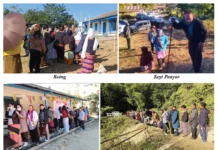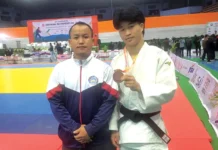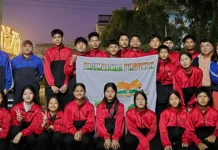[ Nabanita Deshmukh ]
The variety of languages that exists in the world is astounding, yet sadly, from a pool of 7,000 living languages, nearly 3,000 are endangered.
Indigenous languages are especially prone to extinction because the majority of them are scriptless. The necessity to safeguard these dying languages becomes crucial but there are multiple challenges.
Development and domination
In the tribal belt of Odisha, Kui is the mother tongue of the Kondh people and bears little resemblance to Odia, the dominant language. Over decades,however, Odia has made inroads into the Kondhs’ linguistic regions and today, the youths of the community are reluctant to speak their own language.Also, the non-indigenous population of the area are not supportive of the Kui and make no effort to learn it. On the contrary, the Kondhs are expected to learn Odia and currently Hindi and English have become prevalent due to economic pressures and the popularity of social media.
Additionally, the construction of large dams, mines and other structures in the name of development in tribal areas adversely impacts the environment and undermines core indigenous values and languages. Similarly, the loss of ancestral lands, along with the influx of non-indigenous people into tribal territory pose major threats to tribal language and ethos.
In the face of these daunting challenges, how can indigenous languages be saved?
Language revitalisation programmes
Two decades ago, in West Kameng district of Arunachal Pradesh, elderly members of the Aka Hrusso community spoke their mother tongue – Aka. Nonetheless, there existed, especially among children, a strong inclination towards Hindi; yet today everyone in the community speaks Aka fluently. What really brought about this change?
The shift happened when young, educated Hrusso men and women, along with a few other prominent persons made a conscious effort to speak only Aka at home.
Surprisingly, their effort inspired others to follow suit.
One of those prominent persons is Dr Vijay D’Souza, a linguist and a Jesuit who is currently the director of the North Eastern Institute of Language and Culture (NEILAC) in Guwahati, Assam.
Vijay D’Souza worked relentlessly for 25 years in documenting, revitalising and developing orthography for the Aka language, which was initially oral like the vast majority of tribal languages. His key contribution was to slow down the decline of Aka in towns and reverse the language shift towards Hindi in villages. He says, “One need not abandon one’s mother tongue to learn a new language, be it Hindi or English. Multilingualism is not only good for cognitive development, but it also reflects the very essence of being Indian.”
What is indeed laudable is that the Hrusso community always stood in support of Vijay D’Souza’s initiatives and thus revived their flagging mother tongue. The recently formed Aka Language Academy (ALA) is leading the language revival efforts through literature development, audiovisual content creation and awareness drives. From creating “culturally grounded and scientifically designed textbooks” for children in the Aka language, thecommunity, thanks to the academy’s contribution, has succeeded in making its people proud of their linguistic heritage. Today, Aka is a glowing example of language resurgence.
Indigenous education
An education system that focuses on core tribal values plays an important role in the schooling of indigenous children and helps retain their mother tongue and culture.
Unfortunately, education in most tribal areas follows non-tribal curricula. This trend pushes a large number of youngsters to drop out of school as they are unable to relate to what is being taught in classrooms.
A good example of the mismatch between traditional lifestyles of Ladakhi children and the textbook they follow in class came into focus when it was found that the term ‘zebra crossing’ and ‘traffic lights’ were mentioned in one of their lessons. The children had neither seen a zebra, either in a zoo or in a picture book, nor were there traffic lights in the remote villages where they lived.
Technology
Digital apps provide translation support, educational tools for learning a language, and offer archives of online resources that can be accessed by native speakers or others who want to study languages.
SLS is one such tool. It “refers to the practice of subtitling programmes on TV in the same language as the audio” and goes a long way in promoting reading skills.
The idea of same language subtitling (SLS) for reading literacy, language learning and language conservation by scale was conceived in 1996 by Dr Brij Kothari, a former professor of the Indian Institute of Management, Ahmedabad (IIM-A) who says, “How do you get 1.4 billion Indians to effortlessly keep improving their reading skills lifelong? Simply add SLS to all mainstream entertainment content they already watch.”
SLS, as seen today on screens, is the culmination of a 20 year long research initiated by Kothari at IIM-A. The research on SLS began in 1996 and its first implementation happened on a national scale in August 2002 with Doordarshan’s ‘Rangoli’ programme of Bollywood songs. It has since been applied to education with the creation of AniBooks.
AniBooks are audiovisual stories that have SLS with synchronised narration to help children read and learn a language. They have been scientifically tested in schools and based on eye tracking research studies, it has been found that even weaker readers in class automatically engage with SLS and read along the story. Additionally, SLS has the potential to preserve and nurture languages when applied to indigenous folktales and other cultural content.
Shared responsibilities
Preserving indigenous languages and cultures is not just the responsibility of linguists, academicians, historians, digital creators and politicians; it is a collective responsibility that requires the collaboration of individuals and communities. By supporting and taking part in language revitalisation programmes, motivating youngsters to learn their own mother tongue and using technology to safeguard local culture and stories, one could empower future generations of people, both indigenous and non-indigenous, to ensure that linguistic and cultural diversity continues to flourish across the world. (Deshmukh is currently working on a project for language preservation through folklores with the government of Arunachal Pradesh.)




